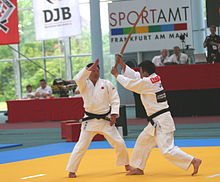This article includes a list of general references, but it lacks sufficient corresponding inline citations. Please help to improve this article by introducing more precise citations. (August 2010) (Learn how and when to remove this template message)
This article relies largely or entirely on a single source. Relevant discussion may be found on the talk page. Please help improve this article by introducing citations to additional sources.Find sources: "Kime-no-kata" – news · newspapers · books · scholar · JSTOR (August 2010)
| Kime no kata | |
|---|---|
 | |
| Classification | Kata |
| Sub classification | Kodokan kata |
| Kodokan | Yes |
| Technique name | |
| Rōmaji | Kime-no-kata |
| Japanese | 極の形 |
| English | Forms of decisiveness |
Kime no kata (極の形) is a series of self-defense oriented katas in judo. Kime no kata, also known as Shinken Shobu no Kata (真剣勝負の形, "the kata of real fighting"), was developed at the Kodokan around 1888. The series is composed of 8 techniques from a kneeling posture (idori waza), and 12 techniques from a standing position (tachi waza). Both sets of techniques contain defenses for both armed and empty-handed attacks.